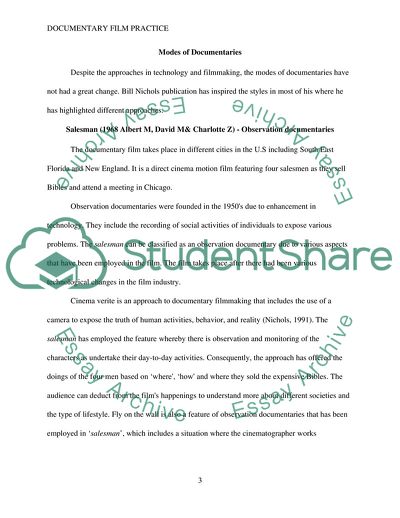Cite this document
(Documentary Film Practice: Thin Blue Line and Salesman Movie Review Example | Topics and Well Written Essays - 2000 words, n.d.)
Documentary Film Practice: Thin Blue Line and Salesman Movie Review Example | Topics and Well Written Essays - 2000 words. https://studentshare.org/visual-arts-film-studies/1877066-considering-the-debates-about-documentary-offered-by-bill-nichols-and-john-izod-richard-kilborn-discuss-two-of-the-documentaries-the-thin-blue-line-salesman-as-examples-of-documentary-film-practice
Documentary Film Practice: Thin Blue Line and Salesman Movie Review Example | Topics and Well Written Essays - 2000 words. https://studentshare.org/visual-arts-film-studies/1877066-considering-the-debates-about-documentary-offered-by-bill-nichols-and-john-izod-richard-kilborn-discuss-two-of-the-documentaries-the-thin-blue-line-salesman-as-examples-of-documentary-film-practice
(Documentary Film Practice: Thin Blue Line and Salesman Movie Review Example | Topics and Well Written Essays - 2000 Words)
Documentary Film Practice: Thin Blue Line and Salesman Movie Review Example | Topics and Well Written Essays - 2000 Words. https://studentshare.org/visual-arts-film-studies/1877066-considering-the-debates-about-documentary-offered-by-bill-nichols-and-john-izod-richard-kilborn-discuss-two-of-the-documentaries-the-thin-blue-line-salesman-as-examples-of-documentary-film-practice.
Documentary Film Practice: Thin Blue Line and Salesman Movie Review Example | Topics and Well Written Essays - 2000 Words. https://studentshare.org/visual-arts-film-studies/1877066-considering-the-debates-about-documentary-offered-by-bill-nichols-and-john-izod-richard-kilborn-discuss-two-of-the-documentaries-the-thin-blue-line-salesman-as-examples-of-documentary-film-practice.
“Documentary Film Practice: Thin Blue Line and Salesman Movie Review Example | Topics and Well Written Essays - 2000 Words”. https://studentshare.org/visual-arts-film-studies/1877066-considering-the-debates-about-documentary-offered-by-bill-nichols-and-john-izod-richard-kilborn-discuss-two-of-the-documentaries-the-thin-blue-line-salesman-as-examples-of-documentary-film-practice.


